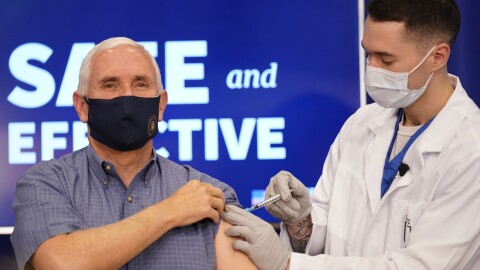Health officials are administering the first doses of a coronavirus vaccine in Indigenous communities across the U.S., one of the populations most vulnerable in the pandemic.
About 68,000 COVID-19 vaccine doses will initially be distributed among the population, the Indian Health Service said last week. Doses began to arrive this week and will first be given to the elderly and health care workers.
"We are so happy I can't even describe it," said Dr. Dakotah Lane, medical director of the Public Health Department and a Lummi Nation member, according to the Associated Press.
The coronavirus ravaged American Indian communities even after tribal governments implemented numerous control measures. Tribes ordered closures, roadblocks, universal testing and curfews but cases continued to rise.
Native Americans already faced health care inequities before the pandemic and are four times as likely to be hospitalized with COVID-19. Historically, Indigenous populations in economically developed countries contract vaccine-preventable diseases at much higher rates.
The Navajo Nation has been hit especially hard. The nation of 170,000 has recorded 20,000 coronavirus cases and at least 731 deaths since the start of the pandemic.
"The arrival of the Pfizer vaccine is a blessing for all of our people, including the doctors, nurses, and many other health care warriors," Navajo Nation President Jonathan Nez said in a statement. "I truly appreciate all of the health care workers who are dedicating themselves to fight COVID-19 and save lives."
Tribes can select their preferred distribution method between the federal Indian Health Service or state health agencies. In some cases the state agencies have more trust within tribal communities, according to AP.
The Indian Health Service is an agency in the U.S. Department of Health and Human Services and maintains a health service delivery system for 2.6 million American Indians and Alaska Natives across 37 states.
American Indian populations were disproportionately affected by the 2009 H1N1 influenza virus outbreak. Kailee Fretland, an Indian Health Service hospital pharmacist at the Red Lake Nation in Minnesota, helped design the vaccine distribution plans in an effort to avoid the same problem, according to AP.
"We went back and we reflected on what happened with H1N1," Fretland said. "The tribes were often not prioritized and we wanted to make sure that that did not happen with COVID."
MPR reports that Minnesota tribal nations were among the earliest to receive the vaccine and credit their careful planning for distribution.
Copyright 2021 NPR. To see more, visit https://www.npr.org. 9(MDA5NTM4MTIyMDE0MTg3NDc2MTVlZjdmNQ001))




